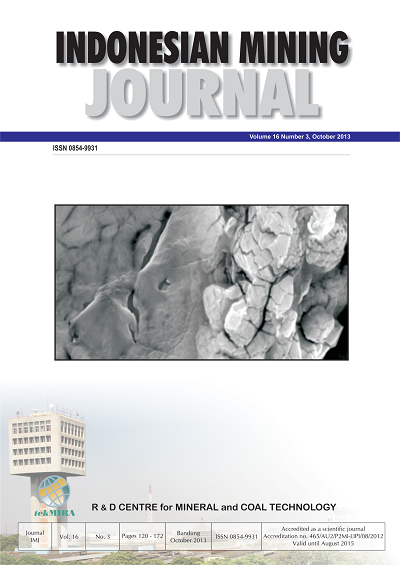EFFECT OF OXIDIZING AGENTS IN EXTRACTING GOLD FROM ANODE SLIME
DOI:
https://doi.org/10.30556/imj.Vol16.No3.2013.382Keywords:
anode slime, wet chlorination, extraction, gold, oxidation, oxidizerAbstract
Anode slime is a byproduct collected from electro refining copper process. The valuable metals present in the slime are Au, Ag, Pt, Pd and Pb. Yet, the slime has not been processed in Indonesia but sent to another country. Extracting the gold from anode slime had been attempted in the laboratory by applying wet chlorination method. Sodium hypochlorite (NaOCl) and hydrogen peroxide (H2O2) served as the oxidizing agents. Effects of various parameters such as solvent concentration, leaching time and temperature on the percent extraction of gold were studied. The optimum recovery of gold with NaOCl is 98.86 % Au at leaching temperature of 40°C, solvent concentration 5 M, NaOCl 5 mL and 20% solid after 120 minutes leaching time. Silver loss under this condition is 2–3%. Leaching the gold by H2O2 provided the highest gold extraction of 99.99% Au at 7M HCl concentration, temperature 60°C, H2O2 0.5 M, leaching time 180 minutes, and 20% solid. The silver loss under this condition is only 0.6%.
References
Amer, A.M., 2002. Processing of copper anodic-slimes for extraction of valuable metals, Physicochemical Problems of Mineral Processing, 36, p. 123-134.
Bard, Gabrielle and Sobral, 2008. Extraction of gold, silver and copper from the copper electrorefining anode slime; separation of the metals, Global Symposium on Recycling, Waste Treatment and Clean Technology.
Hait, J., Jana, R., Vinay, and Sanyal S., 2002. Some studies on sulfuric acid leaching of anode slimes with additives, Industrial Engineering Research, 41, 6593-6599.
Hoffman, 1990. The wet chlorination of electrolytic refinery slimes, JOM, 42(8), p. 50-54.
McClincy, R.J, 1990. Un-locking refractory gold ores and concentrates, JOM, Sept., p. 10-11
Kucha, H. and Cichowska, K., 2001. Precious metals in copper smelting products, Physicochemical Problems of Mineral Processing Journal, 15, p. 91-101
Kusnierov, M, Sepelk, V, and Briancen, J. 1993. Effects of biodegradation and mechanical activation on gold recovery by thiourea leaching, JOM, Dec., p. 54-56
Ludvigsson, B. and Lasson, S., 2003. Anode slimes treatment; The Boliden Experience, JOM, April, p. 41-42.
Rodliyah, I., Ardha, N., Saleh, N., and Mubarok, Z., 2011. Leaching the lead from anode slime by ammonium acetate solution, Indonesian Mining Journal, Vol. 14, No. 3, p. 123-132.
Schulze, R.G, 1984. New aspects in thiourea leaching of precious metals, Int. Precious Metals Sympo- sium, Los Angeles, Feb., p. 27-29
Wang, S, Westrom, B, Fernandez, J.A 2003. The recovery of tellurium from copper refinery slimes. In: COBRE 2003 Volume V, Santiago Chile, Nov. 30-Dec 3, 2003, p. 273-285
Downloads
Issue
Section
License
Indonesian Mining Journal provides immediate open access to its content on the principle that making research freely available to the public to supports a greater global exchange of knowledge.

This work is licensed under a Creative Commons Attribution-NonCommercial 4.0 International License.













